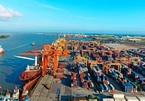

Despite facing numerous challenges and risks, the Vietnamese economy in 2022 is forecast to bounce back, with some of its primary growth drivers coming from industries driven by the COVID-19 pandemic, according to industry experts.
Economists predict that the local economy will recover and regain its growth momentum in 2022 thanks to the macroeconomic stability it maintained in 2021.
Last year saw the export turnover of goods stand at an estimated US$336.25 billion, up 19% compared to the previous year, thereby making Vietnam the 22nd largest export economy in the world.
With such encouraging results, exports are set to continue to represent the growth engine for the Vietnamese economy in 2022, creating opportunities for businesses to promote exports in the coming time.
Amid production and supply chain disruptions caused by the pandemic, Vietnam managed to maintain stable prices of essential commodities, helping contain the inflation rate below 2%.
Furthermore, the foreign exchange reserve level of more than US$100 billion, coupled with the increase in value of the domestic currency (VND) by approximately 1% against the US dollar, has also contributed to stabilising the macroeconomy and controlling inflation in general.
Apart from regulating monetary and fiscal policies, the government introduced a number of policies aimed at reducing lending interest rates, supporting social security, curbing the budget deficit, and drastically promoting public investment. These policies have all served as crucial foundations for the local economy to overcome difficulties and gather steam following the containment of the pandemic.
Prof. Dr. Hoang Van Cuong, vice president of the National Economics University, emphasises that the macroeconomic stability with all indexes controlled within limits have helped to consolidate the confidence of financiers in the Vietnamese investment climate, thus facilitating the greater flow of foreign investment in the future.
Risks continue to persist in 2022
Apart from growth opportunities, Nguyen Minh Cuong, chief economist of the Asian Development Bank (ADB), also warns of a number of risks faced by the country that could primarily arise from the financial system due to rising bad debts coupled with asset bubbles and fluctuations occurring in the stock market.
Moreover, Cuong points out that the implementation of public investment and bailout packages remains sluggish, noting that the timely disbursement of the economic recovery scheme is of great significance in 2022 and 2023.
How will GDP grow ahead in 2022?
With regard to Vietnamese economic growth scenarios in the year ahead, the Asian Development Bank (ADB) projects that Vietnamese GDP growth would stand at 6.5%.
According to the ADB, export activities will continue to represent a growth engine thanks to the utilisation of numerous free trade agreements.
Meanwhile, HSBC says that the local economy can regain its GDP growth rate of 6.8% this year, largely mainly thanks to strong foreign investment flow, with a specific focus on the manufacturing sector and green development.
Dr. Can Van Luc, a member of the National Monetary and Financial Policy Advisory Council, reveals that the national economy is gradually gathering full steam, particularly after the Government issued Resolution No 128 on living safely with the COVID-19 pandemic.
This change has had a positive impact on the macroeconomy as GDP in the fourth quarter grew by 5.22% against the same period from the previous year, helping GDP for the entire year grow by 2.58%.
Moving forward, the Vietnamese economy in 2022 is expected to follow two scenarios, says Luc.
In the event that Vietnam has effectively deployed pandemic prevention measures and the US$15 billion economic recovery programme in 2022 & 2023, the national economy is likely to grow by between 6.5% and 7%.
In the event that COVID-19 response remains inconsistent and the socio-economic recovery programme slows going, GDP growth is likely to rise between 5% and 5.5%.
In order to achieve the set goal of recording economic growth at between 6% - 6.5%, Luc underlines the importance of the Government’s determination to implement the "multi-objectives" by combating the pandemic, reviving the national economy, ensuring health care capacity, and withstanding external shocks. This is along with taking full advantage of opportunities to overcome challenges both during and after the pandemic.
The economic expert also emphasises the need to fine-tune the legal system and substantially improve the investment climate to remove barriers faced by businesses as soon as possible.
He stresses the necessity of supporting businesses in digital transformation and creating conditions in which a number of large enterprises can take the lead in connecting value chains.
Source: VOV

New support package to help economic recovery post-pandemic
When the Covid-19 pandemic broke out, Vietnam was in a zero-vaccine state, so it had to implement social distancing to protect people's health and life.

Pumping money to restore the economy: time is running out
Without solutions to support the economy, the average growth rate in the 2021-2025 period is forecast to only reach 5.4%/year, lower than the target set from 6.5-7%/year.